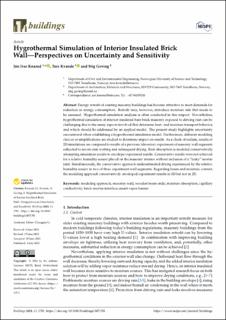| dc.contributor.author | Knarud, Jon Ivar Belghaug | |
| dc.contributor.author | Kvande, Tore | |
| dc.contributor.author | Geving, Stig | |
| dc.date.accessioned | 2023-07-31T11:33:03Z | |
| dc.date.available | 2023-07-31T11:33:03Z | |
| dc.date.created | 2023-07-04T16:47:05Z | |
| dc.date.issued | 2023 | |
| dc.identifier.issn | 2075-5309 | |
| dc.identifier.uri | https://hdl.handle.net/11250/3081950 | |
| dc.description.abstract | Energy retrofit of existing masonry buildings has become attractive to meet demands for reduction in energy consumption. Retrofit may, however, introduce moisture risk that needs to be assessed. Hygrothermal simulation analysis is often conducted in this respect. Nevertheless, hygrothermal simulation of interior insulated bare brick masonry exposed to driving rain can be challenging due to the many aspects involved that determine heat- and moisture-transport behavior, and which should be addressed by an applied model. The present study highlights uncertainty encountered when establishing a hygrothermal simulation model. Furthermore, different modeling choices or simplifications are studied to determine impact on results. As a check of realism, results of 2D simulations are compared to results of a previous laboratory experiment of masonry wall segments subjected to severe rain wetting and subsequent drying. Rain absorption is modeled conservatively, attempting simulation results to envelope experiment results. Conservative results were not achieved for a relative humidity sensor placed on the masonry interior without inclusion of a “leaky” mortar joint. Simultaneously, the conservative approach underestimated drying experienced by the relative humidity sensor in two of three experiment wall segments. Regarding beam-end moisture content, the modeling approach conservatively enveloped experiment results in 3D but not in 2D. | en_US |
| dc.language.iso | eng | en_US |
| dc.rights | CC BY 4.0 | * |
| dc.rights.uri | http://creativecommons.org/licenses/by/4.0/ | * |
| dc.subject | Modeling approach | en_US |
| dc.subject | Masonry wall | en_US |
| dc.subject | Wooden beam ends | en_US |
| dc.subject | Moisture absorption | en_US |
| dc.subject | Capillary conductivity | en_US |
| dc.subject | Brick–mortar interface | en_US |
| dc.subject | Smart vapor barrier | en_US |
| dc.title | Hygrothermal Simulation of Interior Insulated Brick Wall - Perspectives on Uncertainty and Sensitivity | en_US |
| dc.type | Peer reviewed | en_US |
| dc.type | Journal article | en_US |
| dc.description.version | publishedVersion | en_US |
| dc.rights.holder | © 2023 The authors | en_US |
| dc.subject.nsi | VDP::Teknologi: 500 | en_US |
| dc.source.volume | 13 | en_US |
| dc.source.journal | Buildings | en_US |
| dc.identifier.doi | 10.3390/buildings13071701 | |
| dc.identifier.cristin | 2160834 | |
| dc.relation.project | Norges forskningsråd: 237859 | en_US |
| dc.source.articlenumber | 1701 | en_US |
| cristin.ispublished | true | |
| cristin.fulltext | original | |
| cristin.qualitycode | 1 | |

